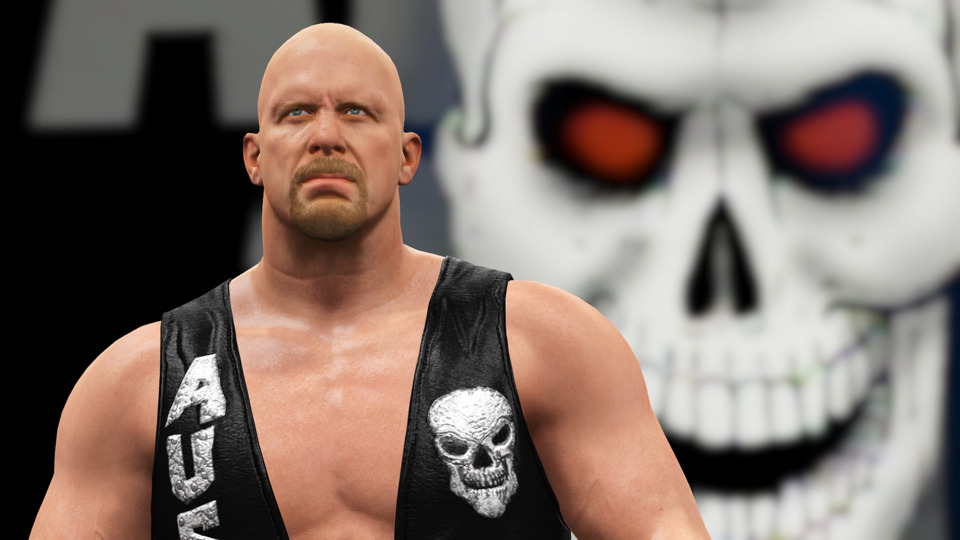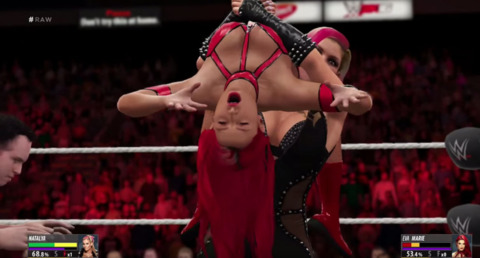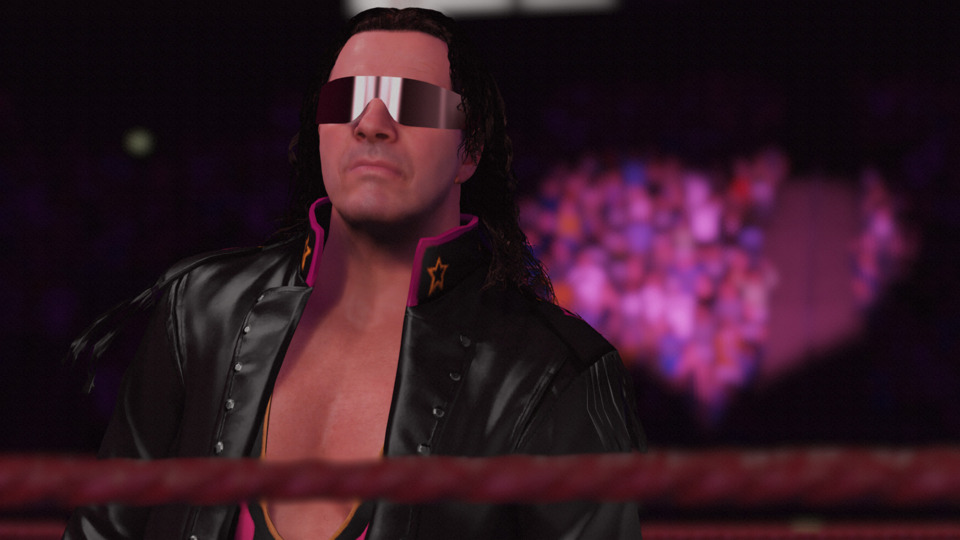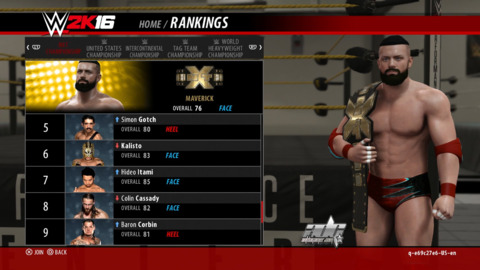No entertainment company has a more complicated relationship with its own history than the WWE. As announcer Michael Cole reminds us often both on television and in the company's licensed video games, Monday Night RAW is the longest running weekly episodic television show in history, and the company's stamp on popular culture runs even a great deal longer into the past than that. Yet the way the WWE chooses to leverage that long, exhaustively documented history is peculiar. The WWE Network, the company's perpetually not-quite-successful-enough streaming service, is an astonishingly rich collection of all that has come before in the world of WWE (and whatever other tape libraries they've seen fit to purchase), but rarely do you see that history portrayed with any significance on any of the weekly television programs.
At best, history is periodically acknowledged, gestured toward, when a superstar of old is up for a Hall of Fame induction, or available for a brief public appearance. And even in those appearances, histories are only relevant insofar as they relate to what's happening this week, what rivalry is the current focus of storylines. History in the WWE is a marketing tool, a way to gin up interest in an episode where perhaps less is going on than usual. Here's Ric Flair to deliver a trademark "Woo!" while "putting over" his daughter. Here's Shawn Michaels, fresh from his latest trip to Cabela's, to tell the current world heavyweight champion why he's just an also-ran of the Heartbreak Kid. Here's Stone Cold Steve Austin to deliver a few hell yeahs before introducing the Undertaker, without ever diving too deep into the rich, bizarre history the two superstars have with one another. If you don't already know, the longest running weekly episodic television show in history isn't going to fill in the blanks for you.

That's left to the Network, and, more often of late, the video games. Since WWE '13, the developers of WWE video games have been providing fairly detailed, interactive retellings of the company's watershed moments. Whether it's 30 Years of Wrestlemania, or an overview of the fabled Attitude Era, these games have become not just tools for players to create their own WWE-flavored moments, but loose history lessons as well. You play through whatever the WWE and the development team consider to be the biggest, most relevant moments of an event, of an era, or even a single feud. This year, the focus is on Austin, whose 14-year career peaked during the WWE's most tumultuous period, who Vince McMahon often credits for ushering in the Attitude Era and saving his company. And like those infrequent, one-off appearances on WWE's weekly television, Austin's expanded presence seems meant to gin up interest in a video game series that, over the last couple of years, has had a bit less going on than usual.
Where last year's game tried to assemble a handful of unassociated feuds into a game that already felt barren and disjointed compared with its predecessors, the history of Austin's career makes for a decidedly easier sell. Though it covers some of the same ground as WWE '13's Attitude Era mode, WWE 2K16's Austin showcase is a solid walking tour of many of the biggest matches and feuds of his career. It occasionally veers into the more obscure, early era matches he had in WCW and ECW, but largely keeps its focus on his rise from King of the Ring '96 through his historically long feud with Mr. McMahon and his various cronies. Like previous years, you engage with this history by playing through these matches, hitting specific moves and quick time events along the way. The core beats of each match are reenacted with decent accuracy, except where licensing issues prevent it. For perhaps obvious reasons, the Owen Hart portion of Austin's lengthy feud with the Hart Foundation is glossed over in video clips, as Hart isn't playable in the game. Similarly, Mike Tyson isn't present for his "enforcer" role in Austin's title-winning Wrestlemania 14 match against Shawn Michaels. Instead, it's an unnamed figure who does his best to stay out of the player's field of view as much as possible.
Occasional veering from the legitimate history like this isn't a huge problem. More of an issue is the way these modes go about making the player engage with that history. As the years have gone on, the Showcase matches have gotten more cavalier about pulling control from the player in service of more accurate, non-playable cutscenes. Significant chunks of all the main matches in Austin's showcase do this, either asking you to hit a quicktime button press (sometimes after an unpleasantly long wait period, which prevents you from paying attention to anything on-screen besides the button overlay), or do nothing at all as history plays out in front of you. A few of these would go a long way, but some matches have in the neighborhood of 10-12 objectives that range from simply damaging an opponent to highly specific moves. This mode has always tried to walk a thin middle ground between total adherence to history and player freedom, and I'd argue this year's is a little better about avoiding super frustrating objectives. But it's not completely devoid of them, and a few too many matches still became repetitive chores as a result.
The focus on Austin and his era in 2K16 has another, probably unintended nostalgic consequence. Austin's rise also happens to coincide with what many consider to be the peak of the wrestling video game genre. As Austin came to power, AKI's various WWE and WCW N64 games, alongside 2K16 co-developer Yuke's' own SmackDown series on the PlayStation and PlayStation 2, were thriving. Those games are, for better or worse, still invoked by fans of this genre today, often when complaining about the current line of WWE games. 2K16 reminded me of the time I spent playing those AKI wrestlers as a teenager, and in so doing, simultaneously made me realize how far these games have come, and how much hasn't really changed for the better.

Look, if you hold any of those old games directly up to the light of 2K16, the differences are unsurprisingly stark. 2K16 is by far the closest a developer has come to recreating the in-ring choreography of a modern WWE match. In addition to the chain wrestling mechanics added last year, matches now feature a host of small touches that tip the scales toward that ever moving goalpost of total realism. Early in matches, you'll see wrestlers back each other into the corner, allowing one or the other to throw in a disrespectful punch or slap as the ref comes between them. Finishers have been reduced in effectiveness a bit, meaning that, as seen on the television product, it often requires multiple big moves before you'll finally put an opponent down. A new pin meter encapsulates this shift toward longer matches, making it a bit easier to kick out in dramatic fashion following more average moves, while a lousy new submissions meter attempts to more accurately resemble the push/pull between wrestlers as a victim tries to struggle out of a hold (and largely fails). Heel wrestlers have some small AI changes that periodically cause them to exit the ring to regroup, attempt to exit the arena altogether, or pull out an illegal weapon to end a match in a DQ. Reversals have been given their own meter, and a limited number of rechargable uses, effectively limiting the number of times you can switch up a move during a match. Even rest holds, the necessary bane of any match, have been gamified into a stamina draining minigame. Between these changes and a whole host of newly motion-captured move animations, no game has ever looked more like a televised wrestling match.
Yet for all those visual touches, WWE 2K16 still isn't a great deal of fun to play. I called last year's game sluggish, and 2K16 feels near-identical in that regard. It's not just the new animations and stamina systems that create this sensation. If anything, I found myself getting used to the nuances of match pacing this year, learning when my character will just hover over an opponent instead of launching directly into an attack, recognizing where I can get a strike in while an opponent laboriously climbs up the ropes back to his or her feet late in a match. But even as I became accustomed to these traits, 2K16 still felt like it dragged through every single match. Every character feels like they're walking through water. Controls just don't respond with the snappiness you want, and many of the new move animations lack the kind of impact the older, if more busted, animations offered.
Say what you will about those old games, they moved. They had an energy to them that, while perhaps unrealistic, nevertheless was exciting to play. Even some of the recent games in this series offered up similar energy, but as 2K has pushed this series toward the holy grail of total realism, that energy has diminished. In 2K16, Visual Concepts and Yuke's have created a game that mostly accurately portrays the dance you see in the ring every single week, often at the expense of the spirit of what that dance is meant to portray. Moves that used to look brutal and ridiculous now look languid and floaty. Now every time Austin lands a Stone Cold Stunner, especially in showcase cutscenes, it never quite looks right. Or maybe it does look right, and just doesn't resemble the kind of cartoonish over-selling you'd see in years past, where every victim sprang skyward before flipping over dead. Wrestling fans are sticklers for detail, to the point of obsession. Every time one of these games comes out, it's not hard to find players online complaining about this move, or that character model, not sufficiently emulating real life. Perhaps this is the end result of that obsession. What once could be exaggerated out of technological limitation has now been softened by the limitations of wrestling reality.
And for all the realism imbued in the gameplay, WWE 2K16 is still replete with immersion-breaking glitches, bugs, and occasional crashes. Wrestler AI is often predictable, except when it freaks out and leaves characters stuck standing on the top rope, or trying and failing to reenter the ring before a count out. This game still can't seem to handle larger weapons getting thrown into the mix without the physics going wonky, but even outside of gimmick bouts, I've seen characters clip waist-deep through the ring, pinned wrestlers stick to an opponent's hand like they're wearing suction cups, and generally deform in horrible ways. And that's just the visual bugs. The audio has a ton of issues as well, especially in the commentary. JBL's been thrown into the mix this year, and his lines are stitched together in such a way that they only barely gel with the existing lines from King and Cole, which are still overly repetitive and sometimes flat out incorrect. JBL's performance isn't good, but the editing is worse, as three men now try to hold a match-length conversation largely out of time from one another.
Elsewhere, 2K16 has made some strides toward at least rebuilding the tower of modes and match types that last year's game pared down considerably. Most of the creation modes--save for the poor, assumedly dead, story creator--are back, allowing you to build your own championship belts, arenas, and shows in addition to the usual character and logo designers. All of these modes work more or less how they did before they were excised or severely reduced last year, and they're pretty easy to use. The wrestler editor in particular has been streamlined a great deal, now allowing you to preview various items without lengthy load times in-between, and upload face-specific images you can apply to your created grapplers. You can also create diva wrestlers again, which great given the number of major diva wrestlers currently missing from 2K16's "largest roster ever." That roster, mind you, is a pretty solid list of current, upcoming, and classic superstars, though a decent portion of those classic wrestlers are holdover characters from last year's game, seemingly included because those assets had already been generated.

The biggest changes are found in 2K16's MyCareer mode. Introduced last year, MyCareer lets you create a WWE superstar of your own design, and put them through the paces of a full WWE career. Or, at least, that's the idea. Last year's mode was a crushing disappointment, a skeleton of a career mode that ended abruptly, but not before hours of meaningless matches that offered almost no story or character progression beyond basic statistics. This year's is a little better. You start off the same way, joining the NXT roster and working through some early tutorial matches. However, it's not long before the game puts you in your first rivalry. This system tracks your relationship with other superstars on your show's roster, fluctuating between ally and rival depending on what you do. Or, it says it depends on what you do, though just as often it appears left to the whims of the computer.
Essentially, you or your would-be rival have the ability to interfere in each other's matches, either attacking before it even starts, or getting involved in the middle of the action. Rivalries are determined exclusively by who you choose to attack and interfere with, and who the computer picks in absence of a choice of your own. You advance your career by winning titles, which you build toward by besting other wrestlers currently vying for that belt. You repeat this process over and over again, checking off some achievement goals required to qualify your career for the WWE Hall of Fame while either meeting or failing objectives laid out for you by The Authority, and that's pretty much it. Sprinklings of story appear from time to time, which offer some branching choices, but it's all pretty lightweight. Still, those scenes are better than the uniformly terrible interview segments with an animatronic Renee Young, which exist to push your mostly meaningless personality traits in one direction or another.
Mostly, it's up to you to fashion the stories in your own head as you grind through the lengthy array of matches the mode presents you with. That grind isn't as bad as last year, since there are things you can do in it outside of just winning and losing matches, but it does feel somewhat imbalanced. You start off the mode as an extremely low-rated wrestler, regardless of what rating you assigned the character in the creation mode. In order to build that wrestler up, you have to spend earned skill points on individual attributes, as well as unique skills (like dirty pins, high flying moves, and the like). This puts you at a significant disadvantage for much of your NXT run, as the number of points you're earning per-match (especially if you're losing) don't equate to significant adjustments to your overall stats. Losing is theoretically not supposed to matter as much as putting on a high quality effort. Everything you do in a match, from move variety to drama heightening pin kickouts and submission breaks, feed into a match rating that tallies up at the end. I was losing four-star efforts on a regular basis, and still only getting a tiny number of skill points, compared to less-exciting wins.
It's worth noting that this is the same system 2K employs in its NBA game, though the trickle of skill points earned there is offset somewhat by the team nature of basketball. If you're an underrated player, you still have the ability to pass the ball around and make different kinds of plays that benefit your team. Here, unless you're in a tag team, you're on your own and forced to grind out those NXT matches until you've built yourself up to a sufficient degree. Or, you could buy the MyCareer Kickstart in the game's DLC shop, which, for ten bucks, lets you bump your MyCareer character up to a 90-rated superstar sans any skill points. It's tempting to say the tediousness of the grind is meant to inspire players to buy this thing, but bumping your character up that high just ensures any halfway experienced player will decimate most every opponent outside of the Brocks Lesnar and Johns Cena of the Universe. That's not a very good solution either.
This is the vibe felt throughout WWE 2K16, one of solutions to problems in last year's game that don't quite go far enough. Take the online modes, which were a hot mess last year. The online interface has gotten a significant cleanup this year, with a proper menu system that lets you engage in private and live matches. It's a much better presentation that is nonetheless hobbled by the game's inconsistent servers. They're not uniformly jacked, but roughly half my time spent online resulted in laggy, barely playable matches where reversal timing became nigh-on impossible. During high volume periods, it's hard to even get the servers to connect long enough to download user created stuff. Things have gotten a bit better in recent days, but I'm still encountering laggy matches on a nightly basis.

WWE 2K16 makes some not-insignificant strides toward improvement, but not a great many. Yes, it's nice that creation modes are mostly back to normal, and that gameplay has begun to shape itself into something other than the half-busted fighting game of years past. But what it's shaping itself into isn't compelling on its own yet. The little touches that emulate what we see on TV week after week don't negate the clunky, uncomfortable feel you're forced to wrestle with every time you play, or the dull, grindy progression of the career mode. What good is a deep and detailed creation suite if you never want to play with the things you create?
This ultimately leaves WWE 2K16 with its history; its largest-ever roster, and deep dive into a career that once revitalized a floundering company. Just as we see on TV from time to time, WWE 2K16 leverages history out of what feels like a lack of confidence in what's currently on offer. 2K16 at least offers a measure of hope that this series can one day again stand on its own, that it can reassemble all the ill-fitting pieces it has collected over the years into something better balanced between hyperrealism and fun. Until then, here's Steve Austin once again to remind you of better times long since past, in the hopes of distracting you from everything wrong with the present.